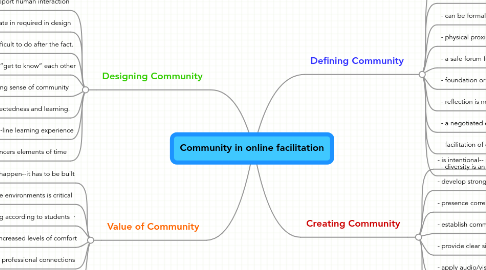Community in online facilitation
저자: James Wanless

1. Value of Community
1.1. - does not just happen--it has to be built
1.2. - teacher presence' in online environments is critical
1.3. more interaction=more learning according to students ·
1.4. - community as a “condition of learning” marked by increased levels of comfort
1.5. - opportunity to establish both personal and professional connections
1.6. - support mechanism contributes to increased levels of knowledge and growth
2. Designing Community
2.1. - use of learning theories and strategies that support human interaction
2.2. - design opportunities for learners to collaborate in required in design
2.3. - building begins from the ground up--difficult to do after the fact.
2.4. - planning for opportunities for people to “get to know” each other
2.5. - the actions of the instructor a primary factor that influences a strong sense of community
2.6. - high levels of interaction with the instructor lead to increased connectedness and learning.
2.7. - “directed facilitation” equates to creating a positive on-line learning experience
2.8. - requires facilitators as affirmers, challengers and influencers elements of time
3. Defining Community
3.1. - sharing a commonality of purpose, passion or vision and who share responsibilities and interact cooperatively to foster opportunities and accomplish goals
3.2. - must support social exchange of information and knowledge
3.3. - can be formal or informal ·
3.4. - physical proximity unnecessary
3.5. - a safe forum for communication
3.6. - foundation or structure is required for sustainment
3.7. - reflection is necessary for the community to progress
3.8. - a negotiated compilation of many ideas.
3.9. - facilitation of discussion is beneficial
3.10. - diversity is an asset co-operation, trust, sharing, collabortation of ideas
4. Creating Community
4.1. - is intentional-- it has to be built
4.2. - develop strong social bonds through interactive activities
4.3. - presence correlates strongly to engagement
4.4. - establish common goal and guidelines using established processes
4.5. - provide clear sign posts --setting the tone, content, and terms of engagement
4.6. - apply audio/visuals for ambiance
4.7. - consider the expertise level and learning style of individual group members


